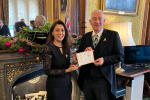
Nusrat Ghani, MP for Wealden, has welcomed the news that the NHS has now rolled out more than 10,000 virtual ward beds to care for patients in their own homes, helping to deliver on a key government priority to cut waiting lists.
Virtual wards allow patients to get hospital-level care at home safely and in familiar surroundings closer to family, friends, and carers, helping speed up their recovery while freeing up hospital beds for patients that need them most.
Nusrat Ghani said: "Thousands of patients have benefitted from the NHS’s ‘hospitals at home’, which give them the opportunity to recover in the comfort of their own homes while being monitored remotely by clinical staff. This approach, also known as ‘virtual wards’, has been shown to benefit patients and eases pressure on the NHS by freeing up hospital beds. These ‘hospitals at home’ will speed up recovery times for patients and help cut waiting lists."
More than 240,000 patients have now been treated on virtual wards thanks to the world-leading initiative.
Research shows that people who are treated at home recover at the same rate or faster than those treated in hospital.
On virtual wards, patients are cared for by clinicians who can provide a range of care, including blood tests, prescribing medication, or administering fluids through an IV drip. They are reviewed daily with a home or virtual visit as part of the ‘ward round’, as well as the use of technology like apps, wearables, and other medical devices so staff can easily check in and monitor their recovery.
The introduction of 10,421 virtual ward beds will allow patients to get expert treatment for illnesses such as chronic obstructive pulmonary disease (COPD), heart failure or frailty conditions at home.
The ambition to deliver 10,000 virtual ward beds by the end of September was delivered despite considerable pressure on urgent and emergency care – September was the busiest month for ambulance services so far this year with 827,690 calls to 999 and a record September for the most serious ambulance incidents, with 77,553 category one callouts.
Last month was also the busiest ever September for A&E staff with 2,165,741 attendances, up almost 8% on the same month last year (2,008,489 in September 2022) and 522,000 emergency admissions last month, up 7.1% on September last year.
